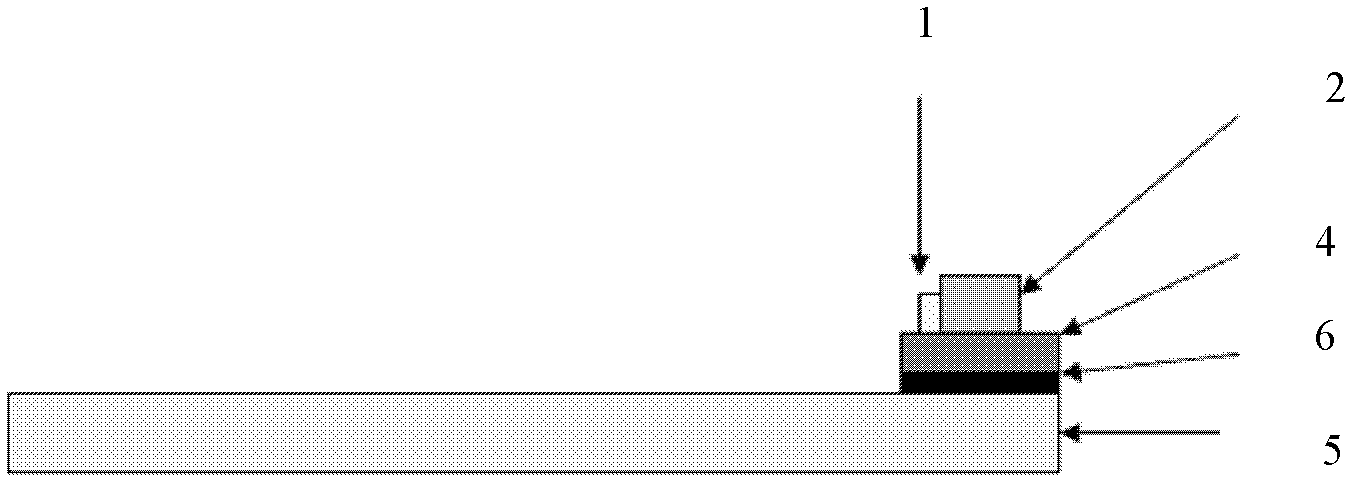Pressure-sensitive acrylic acid thermally conductive adhesive, preparation method for same and application thereof
A heat-conducting adhesive and acrylic technology, which is applied in the direction of adhesives, adhesive types, film/sheet adhesives, etc., can solve problems such as thermal stress, failure, and difficulty in uniform dispersion, and achieve high thermal conductivity and performance stable effect
- Summary
- Abstract
- Description
- Claims
- Application Information
AI Technical Summary
Problems solved by technology
Method used
Image
Examples
Embodiment 1
[0058] The pressure-sensitive acrylic heat-conducting adhesive of this embodiment is made according to the following steps:
[0059] 0.4g azobisisobutyronitrile and 40g ethyl acetate are formulated into initiator solution, and 4g carboxyl content is 1.1% multi-walled carbon nanotube (diameter 100nm, length 500nm) and 16g carbon fiber (carboxyl content is 0.05%, 5000nm in diameter, 6000nm in length), 3g of acrylic acid, 80g of n-butyl acrylate, 20g of 2-ethylhexyl acrylate and 140g of ethyl acetate to prepare a monomer solution;
[0060] In the reactor with material mixing function and temperature control function, the temperature of the monomer solution is raised to 76 ° C, and the initiator solution is added dropwise to the monomer solution for 5 times to carry out the polymerization reaction, and the time of each drop is 10 minutes. After the addition, the reaction was continued for 1 hour. After all the thermal initiator solution was added to the polymerization system, the ...
Embodiment 2
[0064] The pressure-sensitive acrylic heat-conducting adhesive of this embodiment is made according to the following steps:
[0065] 0.35g azobisisobutyronitrile and 30g ethyl acetate are formulated into initiator solution, and 2g carboxyl content is the multi-walled carbon nanotube (diameter 80nm, length 1000nm) of 1.5% and 15g carbon fiber (carboxyl content is 0.09% carboxyl The pitch-based carbon fiber of liquefied, diameter 6000nm, length 7000nm), 4.5g acrylic acid, 50g isobutyl acrylate, 10g lauryl acrylate, 15g acrylate-2-ethylhexyl, and 100g ethyl acetate are mixed with monomer solution;
[0066] In the reactor with material mixing function and temperature control function, the temperature of the monomer solution is raised to 76 ° C, and the initiator solution is added dropwise to the monomer solution for polymerization reaction in 6 times, and the time of each drop is 15 minutes. After the addition, the reaction was continued for 1 hour. After all the thermal initiator...
Embodiment 3
[0069] The pressure-sensitive acrylic heat-conducting adhesive of this embodiment is made according to the following steps:
[0070] 0.5g azobisisobutyronitrile and 45g ethyl acetate are mixed with initiator solution, and 2.5g carboxyl content is the multi-walled carbon nanotube (diameter 30nm, length 500nm) of 2.3% and 17.5g carbon fiber (carboxyl content is 0.05 % carboxylated pitch-based carbon fiber, diameter 5000nm, length 8000nm), 4g acrylic acid, 1g methacrylic acid, 55g n-butyl acrylate, 28g acrylate-2-ethylhexyl, 165g ethyl acetate are mixed with monomer solution;
[0071] In the reactor with material mixing function and temperature control function, the temperature of the monomer solution is raised to 76 ° C, and the initiator solution is added dropwise to the monomer solution for 5 times to carry out the polymerization reaction. The time for each drop is 20 minutes. After the addition, the reaction was continued for 1 hour. After all the thermal initiator solution w...
PUM
| Property | Measurement | Unit |
|---|---|---|
| Diameter | aaaaa | aaaaa |
| Diameter | aaaaa | aaaaa |
| Length | aaaaa | aaaaa |
Abstract
Description
Claims
Application Information
 Login to View More
Login to View More - R&D
- Intellectual Property
- Life Sciences
- Materials
- Tech Scout
- Unparalleled Data Quality
- Higher Quality Content
- 60% Fewer Hallucinations
Browse by: Latest US Patents, China's latest patents, Technical Efficacy Thesaurus, Application Domain, Technology Topic, Popular Technical Reports.
© 2025 PatSnap. All rights reserved.Legal|Privacy policy|Modern Slavery Act Transparency Statement|Sitemap|About US| Contact US: help@patsnap.com



